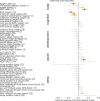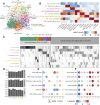This is a preprint.
Genomic dissection of sleep archetypes in a large autism cohort
- PMID: 40236407
- PMCID: PMC11998819
- DOI: 10.1101/2025.04.04.25325272
Genomic dissection of sleep archetypes in a large autism cohort
Abstract
Poor sleep is a major concern among individuals with autism and their caregivers. To better characterize the genetic and phenotypic heterogeneity of poor sleep in autism, we recruited 5,686 families from SPARK, a nationwide genetic study of autism, who described their sleep experiences using the Children's Sleep Health Questionnaire (CSHQ) and other self-report items. The collective experiences from this large sample allowed us to discover eight distinct archetypes of sleep in autism. Membership in some of these archetypes showed significant SNP-heritability (0.50 - 0.65, 95% confidence interval = 0.08 - 1), and polygenic estimates of educational attainment, BMI, and ADHD risk contributed extensively to the genetic signatures of these sleep archetypes. Surprisingly, polygenic estimates of general population sleep phenotypes showed sparser and more modest associations, perhaps suggesting that the genetic drivers of disordered sleep in autism may be distinct from those encountered in the general population. GWAS on archetype membership yielded no genome-wide significant loci, however, the most significant gene for the most severe archetype was the nitric oxide (NO) signaling gene NOS1AP, which was previously linked to sleep disruption in schizophrenia. Finally, the eight sleep archetypes showed specific signatures of treatment response across five major categories of sleep aid, pointing to the potential of treatment plans that are tailored to the nature of the sleep problem. These findings provide critical new insight into the comorbidities, subtypes, and genetic risk factors associated with disordered sleep in autism.
Figures





References
-
- Mazurek M. O., Dovgan K., Neumeyer A. M., and Malow B. A.. Course and predictors of sleep and co-occurring problems in children with autism spectrum disorder. Journal of Autism and Developmental Disorders, 49, pages 2101–2115, 2019. - PubMed
-
- Kuhlthau K. A., McDonnell E., Coury D. L., Payakashat N., and Macklin E.. Associations of quality of life with health-related characteristics among children with autism. Autism, 2017. - PubMed
-
- Petrou A. M., Soul A., Koshy B., McConachie H., and Parr J. R.. The impact on the family of the co-existing conditions of children with autism spectrum disorder. Autism Research, 2018. - PubMed
-
- Nguyen A. K. D., Murphy L. E., Kocak M., Tylavsky F. A., and Pagani L. S.. Prospective associations between infant sleep at 12 months and autism spectrum disorder screening scores at 24 months in a community-based birth cohort. Journal of Clinical Psychiatry, 79(1), 2018. - PubMed
Publication types
Grants and funding
LinkOut - more resources
Full Text Sources
